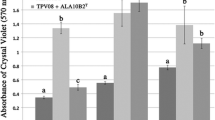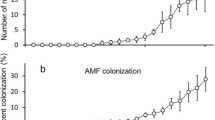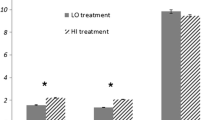Abstract
It is well established that Rhizobium loti and Rhizobium 101/u nodulate Lotus species but not Trifolium repens. We report that a barrier to this specificity can be removed by enzymatically degrading the cell wall at the apices of root hairs of Trifolium repens using a cellulase-pectolyase enzyme mixture and inoculation with R. loti or Rhizobium 101/u in the presence of polyethylene glycol. This treatment enables R. loti to induce the formation of nitrogen fixing nodules on Trifolium repens, and indicates the cell wall at root hair apices as a target site for the genetic manipulation of Rhizobium symbiotic associations.
Similar content being viewed by others
References
Vincent, J.M., Nutman, P.S. and Skinner, F.A. 1979. The identification and classification of Rhizobium, p. 49–69. In: Identification Methods for Microbiologists. F.A. Skinner and D.W. Lovelock (eds.), Academic Press, London.
Broughton, W.J. 1978. Control of specificity in legume-Rhizobium associations. J. Appl. Bact. 45: 165–194.
Beringer, J.E. 1978. Rhizobium recognition. Nature 271: 206–207.
Cocking, E.C. 1985. Protoplasts from root hairs of crop plants. Bio/Technology 3: 1104–1106.
Jarvis, B.D.W., Pankhurst, C.E. and Patel, J.J. 1982. Rhizobium loti, a new species of legume root nodule bacteria. Int. J. Syst. Bacteriol. 32: 378–380.
Allen, O.N. and Hamatova, E. 1973. World Catalogue of Rhizobium Collections. IBP Central Office, 7 Marylebone Road, London, U.K.
Bauer, W.D. 1981. Infection of legumes by rhizobia. Ann. Rev. Plant Physiol. 32: 407–449.
Callaham, D.A. and Torrey, J.G. 1981. The structural basis for infection of root hairs of Trifolium repens by Rhizobium. Can. J. Bot. 59: 1647–1664.
Verma, D.P.S., Zogbi, V. and Bal, A.K. 1978. A co-operative action of plant and Rhizobium to dissolve the host cell wall during development of root nodule symbiosis. Plant Sci. Lett. 13: 137–142.
Davey, M.R. and Power, J.B. 1975. Polyethylene glycol-induced uptake of micro-organisms into higher plant protoplasts: an ultra-structural study. Plant Sci. Lett. 5: 269–274.
Spaink, H.P., Wijffelman, C.A., Pees, E., Okker, R.J.H. and Lugtenberg, B.J.J. 1987. Rhizobium nodulation gene nodD as a determinant of host specificity. Nature 328: 337–340.
Firmin, J.L., Wilson, K.E., Rossen, L. and Johnston, A.W.B. 1986. Flavanoid activation of nodulation genes in Rhizobium reversed by other compounds present in plants. Nature 324: 90–92.
Hutchinson, J. 1964. The Genera of Flowering Plants. Dicotyledones, Vol. 1 Oxford University Press, Oxford.
Plazinski, J., Innes, R.W. and Rolfe, B.G. 1985. Expression of Rhizobium trifolii early nodulation genes on maize and rice plants. J. Bact. 163: 812–815.
Ausubel, F.M. 1982. Molecular genetics of symbiotic nitrogen fixation. Cell 29: 1–2.
Nutman, P.S. 1981. Hereditary host factors affecting nodulation and nitrogen fixation, p. 194–204. In: Current Perspectives in Nitrogen Fixation. A.H. Gibson and W.E. Newton (eds.). Elsevier, Amsterdam.
Skotnicki, M.L. and Rolfe, B.G. 1979. Bacterial and bacteroid properties of mutants of Rhizobium trifolii strain T1 uncoupled in oxidative phosphorylation. Aust. J. Biol. Sci. 32: 501–517.
Vincent, J.M. 1970. A manual for the practical study of root nodule bacteria. IBP Handbook 15. Blackwell Scientific Publications, Oxford.
Fåhraeus, G. 1957. The infection of clover root hairs by nodule bacteria studied by a simple glass slide technique. J. Gen. Microbiol. 16: 374–381.
Rolfe, B.G., Gresshoff, P.M. and Shine, J. 1980. Rapid screening for symbiotic mutants of Rhizobium and white clover. Plant Sci. Lett. 19: 277–284.
Scott, D.B. and Ronson, C.W. 1982. Identification and mobilization by cointegrate formation of a nodulation plasmid in Rhizobium trifolii. J. Bact. 151: 36–43.
Spurr, A.R. 1969. A low-viscosity epoxy resin embedding medium for electron microscopy. J. Ultrastruct. Res. 26: 31–43.
Reynolds, E.S. 1963. The use of lead citrate at high pH as an electron opaque stain in electron microscopy. J. Cell Biol. 17: 208–212.
Witty, J.F. 1979. Acetylene reduction assay can overestimate nitrogen-fixation in soil. Soil Biol. Biochem. 11: 209–210.
Wacek, T.J. and Brill, W.J. 1976. Simple, rapid assay for screening nitrogen-fixing ability in soybean. Crop Sci. 16: 519–523.
Author information
Authors and Affiliations
Rights and permissions
About this article
Cite this article
Al-Mallah, M., Davey, M. & Cocking, E. Enzymatic Treatment of Clover Root Hairs Removes a Barrier to Rhizobium-Host Specificity. Nat Biotechnol 5, 1319–1322 (1987). https://doi.org/10.1038/nbt1287-1319
Received:
Accepted:
Issue Date:
DOI: https://doi.org/10.1038/nbt1287-1319
- Springer Nature America, Inc.
This article is cited by
-
Establishing symbiotic nitrogen fixation in cereals and other non-legume crops: The Greener Nitrogen Revolution
Agriculture & Food Security (2017)
-
Growth stimulation and management of diseases of ornamental plants using phosphate solubilizing microorganisms: current perspective
Acta Physiologiae Plantarum (2016)
-
Diversity of indigenous endophytic bacteria associated with the roots of Chinese cabbage (Brassica campestris L.) cultivars and their antagonism towards pathogens
Journal of Microbiology (2016)
-
Molecular Characterization of a Fungicidal Endoglucanase from the Cyanobacterium Calothrix elenkinii
Biochemical Genetics (2013)
-
Effect of Plant Age on Endophytic Bacterial Diversity of Balloon Flower (Platycodon grandiflorum) Root and Their Antimicrobial Activities
Current Microbiology (2010)




